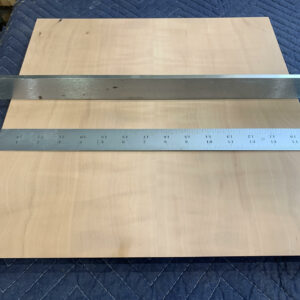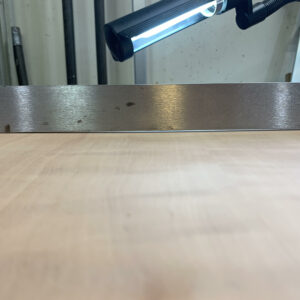I have a 15″ sq. table top that wants to cup slightly. I flattened it at oversized and let is rest for several weeks. I then cut it to final size, edge formed, and let is rest about 10 days. I then flatten it. After waiting to see if it would remain flat I noticed it had cupped slightly. I flattened it again taking the edges on one side and the middle on the other about 1/32 and now it is slightly below the intended thickness, which I was fine with. After resting again, I see about a 1/16 cupping again.
I’m afraid it will cup more if I flatten it again. Can this go on and on? In your opinion how flat does a table need to be? Should it be just flat enough to have stability for a glass or should it be flat within some tolerance?
I have done live edge stuff that looks fine with some slight sloping areas. Indeed, just looking for some opinions from my fellow woodworkers.
Thanks, Rob


















Replies
My first thoughts are the wood was not stabilized before you started milling it, because everything you've done is text book.
One thing I would have done differently is to do my final flattening right before attaching it to the base or legs. Wood is always going to want to move but if you had attached it to the legs immediately it may have been able to resist the movement sufficiently.
Another question I have is while you were letting it rest did you allow for air movement on all sides? If it was sitting as it is in the photo it will cup because moisture can only enter or leave the top from one side.
The top was rested up on stickering strips. The top is attached to a floating top base, so it is really only attached by a four screws from the two inside stretchers. I don't believe this will restrain movement. I will finish it separately before attaching hence a lot of resting between steps.
An interesting thing happened. The new cupping was noticed after my anticipated final flattening and leaving the top on the piece of moving blanket shown the picture. After I raised it back on the sticker wood (post some minor additional flattening) the top became flat again. It looks like my leaving it on the blanket tricked me into thinking it would keep cupping. Sitting on the blanket cause a change in the moisture equilibrium. I think it will be fine on the table because the sticker wood is similar to how it is attached.
Is that an original design? It looks good. Please post a picture of it finished.
Several questions present themselves immediately:
1) What wood is it? Some woods like walnut and mahogany are more stable than others like red oak and gum.
2) What is the moisture content history of the wood? Was it kiln dried? How long ago? Where and how has it been stored since?
3) What is the humidity level/temperature in your shop space?
4) How are you placing it while waiting to see if it changes flatness? Are you leaving it flat on a workbench, or putting it up on narrow strips? Is it in the sun some part of the day?
5) How is it cupping compared to the annual rings visible on the end grain? Do the rings bend one way and the cup the opposite? Or similar ways?
I ask all these questions because they are all relevant. If I take a wide board that is badly cupped and flatten one side of it on a jointer, then plane the other side with a thickness planer, and the board comes out with a slight cup instead of staying flat, that is because there were internal stresses in the wood that I unbalanced by planing different amounts of wood off different areas of the board. On the other hand, if the board stays flat and then over time cups, that is due to moisture content changes. Both uneven moisture change (flat on the bench or in the sun) and even moisture change (shop humidity level causing the board to pick up or lose moisture) can cause cupping. The type of wood and how it has been sawn out of the log both determine how much the board tends to cup. Quartersawn wood tends to stay flat; flat-sawn wood tends to cup the most.
So, the real question is what to do in your situation? If the top is on a flat surface and you can push it down to make it flat against the surface, and if you have a straight substructure you can screw it to, just carefully screw it down to make it flat. Most tables with 3/4' thick tops rely on the substructure to keep the top flat while it goes thru seasonal humidity/moisture content changes.
If it was in the sun or picking up a lot of moisture lying on a bench, turn it convex side up in the same situation for a while. But still rely on fastening to a substructure to keep it flat once it flattens out a little. I recently made some 1/4" thick ebony cabinet door panels, and without thinking, left them flat on the work bench for a day, in the sun (think black wood in the sun.) They cupped almost instantly. So I turned them over, and when they had regained flatness, I put them on strips in a part of the shop that the sun never reached. At that point they stayed flat.
I hope all this helps. Feel free to ask further questions depending on the specifics of your situation.
The wood is pear wood that was from a slab. I not sure if it was ever kiln dried. This was a piece of slab left over for another project. It was resawed and book matched. The 2" piece (before resaw) has been in my shop for a year. But after resaw it was processed as described earlier.
The shop is heated with a mini split to the upper 60s and humidity at 27% and tends to be pretty consistent during a season higher in the summer . The wood is showing about 7.4% moisture now.
The rings are running mostly in a rift sawn direction. They are opposite on the two boards from book matching.
Thanks for your feedback it looks to be worked out. See the top reply.
How much a table is allowed to cup is up to you. To answer your question, yes this can go on and on. Every time you flatten it, you remove material and allow it to cup. It would seem there are internal stresses in the wood they still have enough potential energy to cup your top. You may not want to hear it but sometimes it's better to just make another one instead of chasing this one.
You might also consider a design that would help restrain the top from cupping.
The last resort I could suggest is this, you could and I'm not advocating this but you could, over flatten it. Creating a slight cup in the opposite direction and see what happens when it's left to acclimate, you might get lucky, although wood is unpredictable.
Yes, it can go on forever, but depending on what you are going to fasten it to you can tame it. If the table base is a leg and apron setup a few screws up through the apron combine with a few buttons should hold it flat. Allow for seasonal movement in your fastening of course.
Once your base is ready you can get the top flat by putting it on a thin towel on a concrete floor with the cup (concave) side down. Moisture from the concrete will expand the concave side a bit and once it is as flat as it will get slap it on the base and hope for the best. I have a section of basement with thin carpet where I've done this a few times.
One thing that you never mentioned was how you actually stored it... Given that it was cupping before, it's likely going to cup again. You sound like you're doing everything right, except for 1 thing... once you've got it seasoned and to its final size you have to attach that thing. Left sitting around it's going to move, no if's and's or but's. Usually once seasoned and milled flat, having that mechanical advantage of being attached to the base is enough to keep it flat. That's your answer here.... given the amount of time you've put into this, I suggest reflattening it at this point, but only when you're ready to the immediately attach it to the base.
A great tip (from bob van dyke), if you need to leave milled parts(in this case your top) around for some reason - because say you don't have the base build yet, put that piece in a sealed plastic bag, like a garbage bag. Removing it from the air and humidity changes that go with it will keep it more stable. You should still store it appropriately (stickered and flat, top and bottom). When you're ready to attach it, it will be in the same state you left it (theoretically). There is a video where Bob talks about this and extolls about keeping things flat for a long time. I've done it myself when i milled up some table legs that took me literally months to get back around to.... and they were still perfectly straight and true.
Wood moves. You can fasten the top so that it won't cup badly, but still move. But there is only so much you can do.
I never take a straightedge to my furniture. If it has cupped since it was finished, I am blissfully unaware.
If the top is going on a solid apron frame, attaching it should flatten the 1/16th cupping out. Even if it doesn't, I doubt anyone will notice.
I agree with John and Elm, no one will notice.
Hi All, Problem solved... scroll up to see results posted after reply #1
This forum post is now archived. Commenting has been disabled